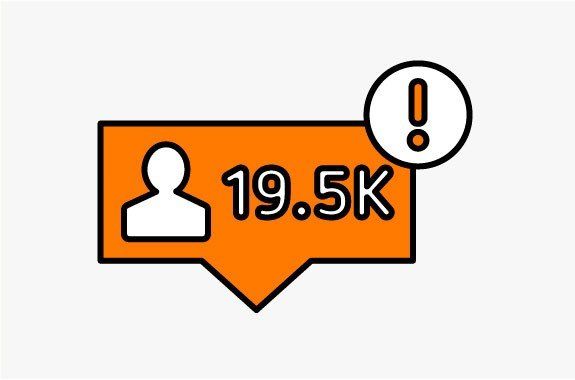Followers are important – engagement is better
A key question that comes up often in social media marketing circles is ‘does more followers equal better response?’
There are two sides to this argument – for one, there’s the social proof element, people are more likely to trust a business that has 1000 followers than one which has none, which makes perfect sense.
But on the other hand, it’s possible to buy followers and Likes, they’re readily available and quite cheap. Because of this, your audience count is not necessarily the best indicator of… well, anything.
Why you need more followers
The truth of the matter, though, is that you need a certain amount of social media followers for your brand to be taken seriously. If you’ve got no one following your page, then it’ll be harder to convince people to get in touch and spend money with you.
So you need numbers – most people build their audience base by sending out invitations to friends and family and getting them on board. And that’s definitely helpful, but it can hurt your marketing efforts in the long run.
How? Because Facebook, for example, uses an algorithm
which shows people your content based on a range of factors, the most significant one being engagement.

So while you might have 1,000 followers, if only a few of them are actively engaging with each and every one of your posts, you actually could be hurting your Facebook performance in the long run.
That being the case, if you’re posting from your business page and all the people who follow that page are friends and family - and not people who are actively engaging with your content – then your engagement rate will be lower.
Lower engagement rate means fewer people see your posts, and Facebook’s algorithm will determine that your posts are not highly relevant and reduce your reach.
So while you might have 1,000 followers, if only a few of them are actively engaging with each and every one of your posts, you actually could be hurting your Facebook performance in the long run.
And while Facebook is the example here, the same applies to Instagram, which now also uses an algorithm, and Twitter too, to a lesser extent.
Non-engaged followers also skew your audience data. If 90% of your audience aren’t actually going to buy from you, then researching them and their interests in your Facebook Insights or Twitter Analytics will be pointless, as any data you gather will likely not actually help you create more resonant material.
So that being the case, how do you build an effective social media audience?
Why you don’t need more followers
The counter to this is that you actually don’t need more followers, but you need more engaged followers. But that, of course, is hard to work with, because building engagement takes time – and as noted, if you don’t have any followers initially, it’s harder to build an audience because people won’t take your seriously.
The trick is to use friends and family to start out, but to remove those who are not engaging with your posts from your audience over time.
This needs to be handled with sensitivity – no one likes being excluded or cut off – but you need your social media audience to be comprised of people actually interested in purchasing your products and services. The only way to truly maximize your social efforts is to have an engaged, active audience on each platform.
You do need audience numbers to start off with, but you need to also be mindful of who those people are and whether they’re following you because you’re friends or because your business is genuinely of interest to them.
And if it’s not, eventually you might need to cut them off.
Engagement vs audience
One of the false tricks of social media is that people often mistake audience size for importance. That’s not how it is. Having 10,000 followers is meaningless if none of them are buying from you – whereas on the other side, having just one paying customer may be all you ever need (if that customer is the exact right one).
The main point is to ensure you’re aware of what your audience growth stats mean and how they relate to your overall goals. Eventually, you’ll want to analyse your audience data to get a better understanding of what they’re interested in so you can cater to those needs. If they’re all your friends, that might be extremely hard to do.
You need audience, no doubt, but you need engagement more. Maintaining awareness of the two is key to maximising your social efforts.
Need help choosing the right marketing solution for your business?
Give us a call on 1800 006 910
to chat with one of our experts, or request a call back.
Related Products
Managed Service
Search Engine Optimisation
Local Starter
from $500 monthly*
We'll drive traffic to your website and deliver hot leads
✔ 5 x locally optimised keywords a month
✔ Get started with Google My Business
✔ Talk to our experts for advice
